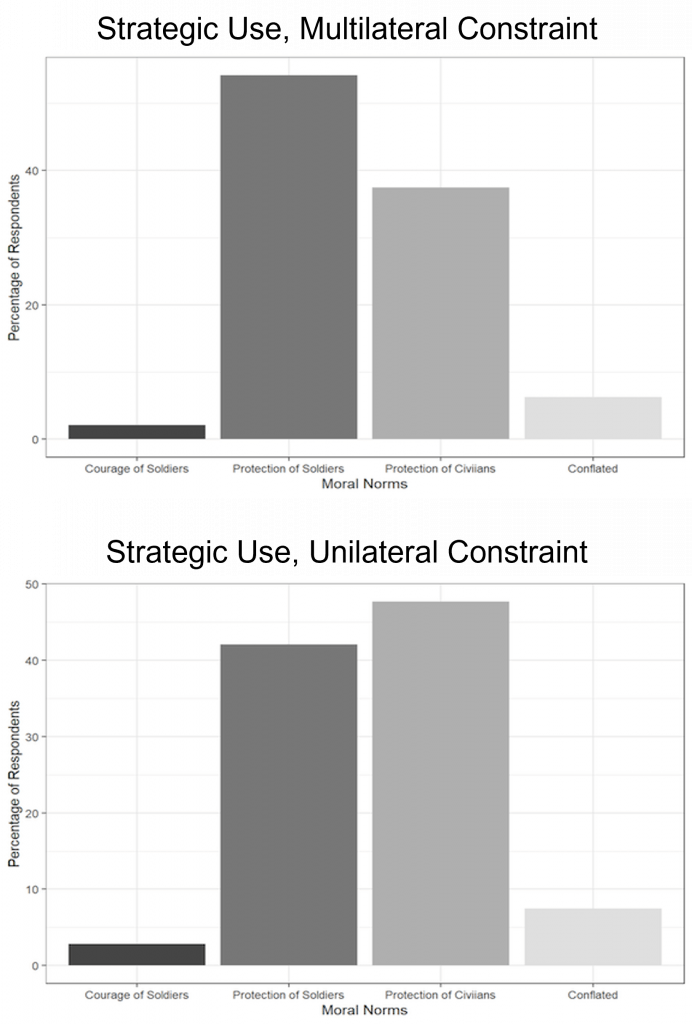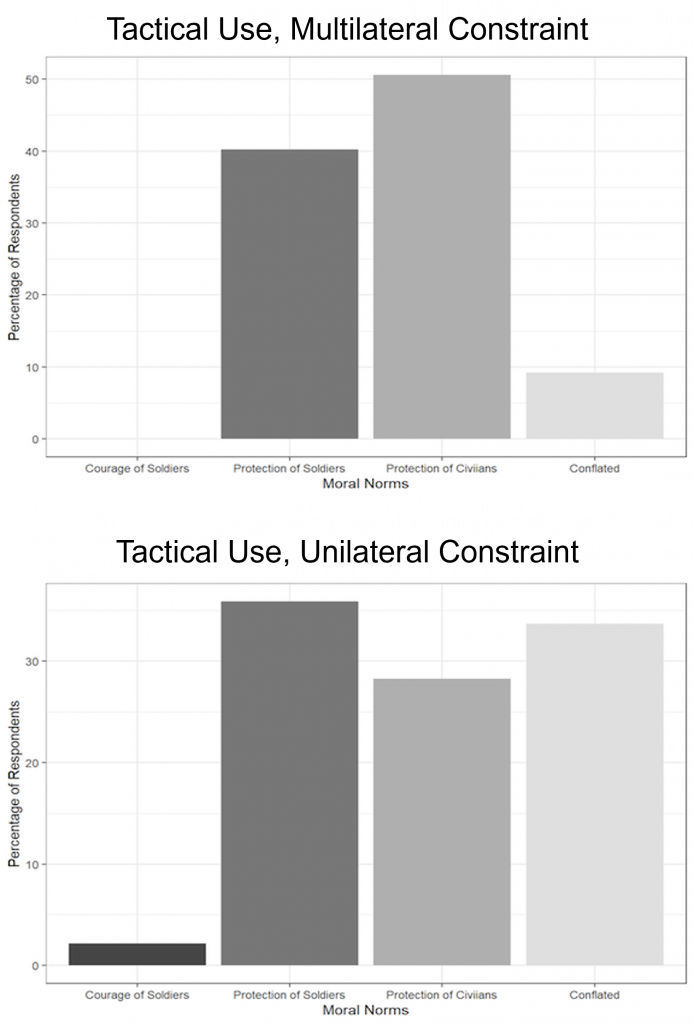Legitimacy—the public’s beliefs in the appropriateness of some behavior—is central to the sustainability of US drone strikes abroad. Research shows that the public does not generally challenge policies and actions it deems legitimate, which helps preserve space for officials to make decisions on sensitive issues like the use of force. In an effort to create legitimacy, US officials extol the virtues of drone strikes. Indeed, military leaders have referred to these operations as “righteous,” even when they inadvertently kill civilians. Charles Rowling and Joan Blauwkamp also find that “US officials routinely invoke polling data to enhance the legitimacy of their policy actions,” including drone strikes.
Yet despite the importance of legitimacy to US drone policy, scholars know little about how the public understands legitimate strikes. The few scholars who have studied the public’s perceptions of legitimacy typically make three claims. Some argue that legitimacy relates to soldiers’ physical courage on the battlefield in executing strikes. For instance, despite or because of the lack of reciprocal risk between combatants during strikes, Christian Enemark claims that drones are “post-heroic” and illegitimate. Others counter that legitimate strikes protect soldiers from physical harm on the battlefield. Bradley Strawser, for example, reasons that officials have a moral obligation to use drones to minimize soldiers’ liability to be harmed during war. Still others claim that civilian casualties shape the public’s perceptions of legitimate strikes. Mitt Regan, for instance, posits that “avoiding civilian harm may be important to the perceived legitimacy of strikes.”
Rather than equate public perceptions of legitimate strikes to just one of these “moral norms,” or standards of expected behavior, I argue that the public may combine them in unique ways based on why and how officials use drones. I recently tested this claim using an original survey experiment with about six hundred Americans. I varied a fictional country’s use of a drone, as well as the constraints placed on such usage.
Countries can use drones tactically or strategically. Tactical strikes are used during hasty engagements with combatants in declared theaters of operations (for example, Afghanistan) to achieve near-term and limited military objectives, such as the defense of ground forces or elimination of an enemy leader. As a foreign policy tool, strategic strikes are principally used in undeclared theaters of operations (such as Yemen) to achieve long-term and broader military objectives, including the defeat of an adversary. Countries can also constrain drones unilaterally or multilaterally—self-imposed or externally levied oversight measures. Well-known examples of these two constrains include, respectively, the standard adopted by President Barack Obama’s administration—“near certainty” of no civilian casualties during strikes—and international approval for strikes.
Varying a country’s drone use and constraints results in four possible drone strike scenarios—as shown in figure 1. After prompting survey participants to read a randomly assigned vignette, I asked each to grade the legitimacy of a drone strike from low (1) to high (10). Next, I used a battery of statistical methods to analyze the data, resulting in three key findings that have implications for US drone policy going forward.
Figure 1. Americans’ perceptions of legitimate drone strikes in terms of moral norms. (Note: The y-axis reflects the percentage of survey respondents who either referenced one moral norm or conflated several moral norms when explaining their perceptions of legitimacy for a drone strike. These moral norms are represented on the x-axis.)
Finding #1: Americans can combine moral norms when judging the legitimacy of strikes.
I found that the public’s perception of a legitimate drone strike is not the function of just one moral norm. Rather, as reflected in Figure 1, it is more complicated than most scholars assume. My results suggest that variation in why and how a country uses a drone can cause the public to reflect on unique combinations of moral norms when adjudicating the legitimacy of a strike.
Americans observing a strike in an undeclared theater of operations with external oversight—which characterizes US drone strikes in Somalia, considering the African Union’s role in synchronizing operations against terrorists—understand legitimacy in terms of keeping soldiers safe. Americans seem to believe external oversight helps protect civilians, encouraging them to emphasize soldiers’ safety more.
This outcome flips when Americans observe a country using drones in an undeclared theater of operations with no external oversight, similar to Turkey’s strikes in Syria. It appears Americans understand that this model of drone warfare imposes unacceptable risks on civilians, causing them to relate legitimacy to the protection of civilians.
Americans get confused when countries use strikes within their own borders. This is surprising since most countries use drones in this way, including Ethiopia in its strikes against the Tigray People’s Liberation Front. In my estimation, such tactical strikes with unilateral constraint now impose the most significant challenge to the global governance of drones, and not US over-the-horizon counterterrorism strikes that are conducted in undeclared theaters of operations without boots on the ground. Such strikes may not represent breaches of international law, given they don’t violate sovereignty norms in the same way as over-the-horizon strikes on a foreign country, but the intrastate use of drones can still result in collateral damage, including civilian casualties, that flies under the radar of public opinion because of a lack of international accountability.
Finding #2: Shifts in why and how a country uses drones can shape perceptions of legitimacy.
A country that receives international approval when using drones, especially from the United Nations, enjoys a higher level of perceived legitimacy for its strikes. This outcome is strongest when a country uses drones within a declared theater of operations, similar to French strikes in Mali.
A country that prefers only unilateral or self-imposed constraint, including the adoption of a “near certainty” standard of no civilian casualties during strikes, causes Americans to question the legitimacy of operations. This outcome is consistent regardless of why a drone is used, either as a tactic within a declared theater of operations or a strategy within an undeclared theater of operations.
At the same time, these results show that the type of constraint can shape Americans’ understanding of a country’s moral liability for civilian casualties. A country that uses drones in a declared theater of operations with international approval, as France did in Mali, can altogether escape moral culpability for collateral damage.
In this case, Americans may relate civilian casualties to what Neta Crawford calls “genuine accident collateral damage.” David Traven also shows that “intended killings are morally worse than unintended, side-effect killings.” Americans, then, apparently adopt this intention/side-effect distinction when reflecting on strikes that are used in declared theaters of operations with international approval.
Finding #3: Other factors can also shape public perceptions of legitimacy.
The public’s perception of legitimacy can also be shaped by sex and level of education. Women are more likely to view drone strikes as legitimate than men. This reinforces research that women are more attuned to the way military force can protect US soldiers. Additionally, more educated Americans are more likely to view drone strikes as legitimate, indicating broader awareness of the intended benefits of drones.
My analysis also indicates that Americans’ support for the use of force abroad has the biggest impact on their understanding of legitimate drone strikes. The more Americans support the use of force abroad, the more they are likely to perceive strikes as legitimate. This reinforces earlier research by Douglas Kriner that finds support for the use of force abroad is a strong predictor of public approval of strikes. I find similar results for conservativism, with conservative Americans more likely to support strikes, which also reinforces previous studies. Charles Rowling and Joan Blauwkamp, for instance, find that supporters of US President Donald Trump approved his use of strikes more than those who disapproved of him. At the same time, polling data shows that Democrats endorsed Obama’s use of drones, suggesting that US counterterrorism drone strikes have enjoyed strong bipartisan support, at least until the operations target US citizens abroad.
Implications for US Drone Policy
These findings have several implications for US drone policy, especially now that President Joe Biden’s administration has adopted an over-the-horizon counterterrorism strategy in Afghanistan and expanded its use of drones in other undeclared theaters of war, particularly Somalia.
First, because Americans discount the legitimacy of over-the-horizon counterterrorism strikes, officials must legitimate these operations by explaining the anticipated gains for national security as well as the measures taken to prevent errors. The record suggests that since President Biden’s botched strike in Afghanistan in August 2021, which resulted in ten dead women and children rather than a suspected Islamic State–Khorasan terrorist, the president has taken care to explain how US forces attempt to minimize harms against civilians when using drones against terrorists.
Second, since Americans support coalitions to offset the burdens of military operations abroad, US officials should also consider expanding the use of drones in support of surrogate forces, even when US soldiers are not deployed on the ground. To be clear, the use of drones for this purpose may confront legal challenges that should be further studied. But my results suggest that Americans will likely perceive this model of strikes as legitimate, similar to their understanding of French strikes in Mali. And the use of drones for this purpose will enhance interoperability with allies and partners while recapitalizing combat power for the mission to deter aggression by near-peer adversaries, namely China and Russia.
Finally, though drones are often considered de-escalatory compared to manned platforms, such as bombers and jets, strikes can heighten tension between countries. Following President Trump’s use of a drone to kill Iranian Major General Qasem Suleimani in January 2020, for instance, Iranian officials lobbed ballistic missiles at US forces in the region. Even today, some three years later, Iranian officials continue to target US forces in the region, promising “harsh revenge” for Suleimani’s death, which they characterize as martyrdom. Besides recognizing the legitimacy costs imposed by these strikes, then, US officials must also study the security implications of drones used in the context of interstate war—an increasingly common phenomenon given Ukraine’s adoption of an “army of drones” to level the playing field during its war with Russia.
Paul Lushenko is a lieutenant colonel in the US Army, deputy director of the Cornell Brooks School Tech Policy Institute, and coeditor of the volume Drones and Global Order: Implications of Remote Warfare for International Society.
The views expressed are those of the author and do not reflect the official position of the United States Military Academy, Department of the Army, or Department of Defense.
Image credit: Senior Airman Christian Clausen, US Air Force



